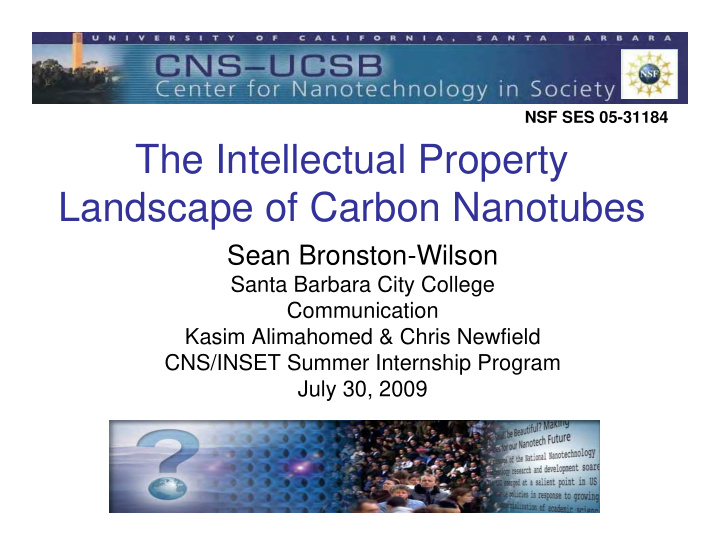



NSF SES 05-31184 The Intellectual Property Landscape of Carbon Nanotubes Sean Bronston-Wilson Santa Barbara City College Communication Kasim Alimahomed & Chris Newfield CNS/INSET Summer Internship Program July 30, 2009
How can we reduce uncertainty about nanotechnology? – CNS Workgroups & Principle Investigators: Photo and caption from ScientificAmerican.com • WG1: Origins, Institutions & Communities – Patrick McCray (History, UCSB) • WG2: Innovation Group – Chris Newfield (English, UCSB) • WG3: Risk Perception and Media “SMALL – Barbara Herr Harthorn (Anthropology, UCSB) PARTICLE, – Bruce Bimber (Political Science, UCSB) BIG DANGER?” • WG4: Globalization and Nanotechnology – Richard Appelbaum (Sociology, UCSB)
The Carbon Nanotube (CNT) • Layers of hexagonally oriented carbon atoms arranged in tubular shapes • Carbon Nanotubes have novel properties: Image from scientificchess.com – Strength & Pliability – Metallic /Semi-Conducting – Thermal Conductivity – Relatively Simple to Produce • Early mention of forming carbon filaments from was reported in 1889. ( Monthioux, M., [2006] Carbon, 44, 1621) • Industry growth attributed to recent advancements in microscopy Image Courtesy of Zyvex
From Innovation to Litigation US Patent #5,424,054 (June 13, 1995) • Nanotech is facing barriers to forward innovation including structural problems with the regulation of intellectual property (IP) (2005, Miller et al.). – An increased volume of patent applications – A lack of resources for patent application review – A shortage of personnel qualified to review nanotech patents Image from patentattorney.com • Additionally, the issuance of broad and overarching patents on key technology innovations can shape industry – Unwanted litigation – The use of IP strangleholds Image courtesy of patentlaw.info
Workgroup 2 Research Goals Tracking innovation: a patent thicket from the Handbook of • Discover paths of CNT innovation by Nanotechnology, tracking patents Business, Policy & Seal of the US Intellectual Property Patent & Law (2005). Trademark • Analyze patents using qualitative and Office quantitative methods. • Understand impact of current US innovation in nanoscale research • Create understanding of social and cultural factors that affect nanoscale innovation
Data Collection • Raw data is dumped into a basic text document by the Oogler (Jerry Macala, Science Policy fellow: CNS UCSB) • Data is then converted to a Word document to be imported into Excel • Excel file is cleaned and organized by hand so that data can be analyzed • Data is analyzed by statistical software (SPSS, The USPTO full text and Excel) image database was used to gather patent information
- Trends in CNT related patent issuances -Over time we see a dramatic increase in the number of issued patents related to carbon nanotubes
- Looking at the number of issued CNT patents arranged by sector we can see private industry dominates the IP landscape of CNT’s in the US. Individual Industry Inventors University Government
- Descriptive statistics can be helpful in analyzing industry trends but in order to identify key players in the CNT industry patents need to be analyzed on a case by case basis Assignees by CNT related patent portfolio size • 2008 Revenue: $103.6 billion • Total Assets: $109.5 billion (2008) • Employees: 398,455 (2008) • IBM holds fundamental intellectual property rights regarding the growth of carbon nanotubes and methods for patterning • US Patent #5,424,054 (June 13, 1995) claiming arc discharge CNT synthesis
Questions for Future Research • How does the CNT industry compare to other nanoscale industries? • With billions of dollars going into R & D why are there so few CNT enabled consumer products? • What is the true value of a CNT patents? • How can we avoid the patent thicket? • How does the US compare to other countries in relation to the innovation and diffusion of nanotechnology
NSF SES 05-31184 Acknowledgements • Special thanks to: – The National Science Foundation – The Center for Nanotechnology in Society – The Internship in Nanosystems, Science, Engineering & Technology – Kasim Alimahomed, Communication, CNS Graduate Fellow (UCSB) – Christopher Newfield, English, CNS Workgroup 2 Principle Investigator (UCSB) – Dr. Kuhn, Dr. Arnold, Dr. Garard & Dr. Cropley (Santa Barbara City College)
Recommend
More recommend